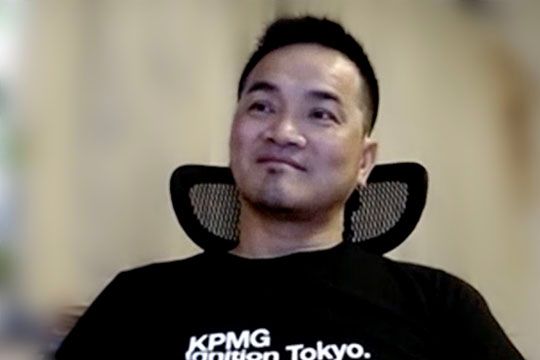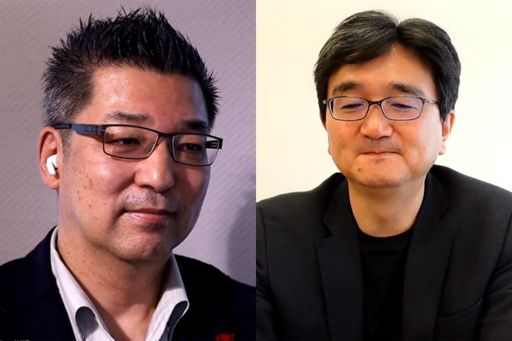“How to renew the IT environment within an organization” is an important theme in promoting DX and implementing digital management.
KPMG Ignition Tokyo (KIT) thinks that the environment necessary to realize digital management includes not only IT infrastructure but also a wide range of factors, such as the ideal state of corporate culture and organizational structure as well as methodologies for promoting projects and the definition of governance.
In this article, we will introduce the discussions regarding the reasons concerned that were conducted between Masayuki Chatani and Tim Denley of KIT and Tsuyoshi Moriya, Director of KIT’s DX Solution 1 Division.
*Professional affiliation and official position in the article are at the time of publication.
Contents
- Conditions for Successfully Achieving DX Promotion and Transition to Digital Management
- Appropriate Rail Tracks Must be Laid Down for New Approaches
- Let’s Overcome the Adverse Effect of Liking Technology Too Much
- Artistic Thinking and Data-Oriented Management Decisions Make the Company Grow
- Ideal Governance for Utilizing Data Must Be Discussed
Conditions for Successfully Achieving DX Promotion and Transition to Digital Management

(Masayuki Chatani, Representative Director & CEO of KPMG Ignition Tokyo and CDO of KPMG Japan(left), Tim Denley, Board Member & Partner of KPMG Ignition Tokyo(center), Tsuyoshi Moriya, Director, Head of DX Solution 1 of KPMG Ignition Tokyo (right))
Denley: When talking about an environment necessary to promote digital management, there are several points that must be discussed. Though we tend to focus on hardware such as IT infrastructure, we should also focus on software including corporate culture, organizational structure, and governance.
I believe that it will be difficult to realize digital management unless we are fully aware of the four quadrants of “education, influence, carrot and stick.” Education will be necessary if the people around you still do not have a full understanding of DX or digital management. Also, it will not be possible for digital management to take root in the organization unless there is someone who can influence others about what digital management is.
The management team must convey to employees at the worksite “what needs to be done and considered going forward” while practicing it themselves and guide them so that “they can move around efficiently” as intended. I don’t think this is a type of thing that can be achieved “naturally.”
Chatani: Tsuyoshi Moriya-san is working actively in the DX Solution 1 Division, which is responsible for supporting the promotion of DX. Moriya-san, I understand that you are now actually providing support so that the organizational culture will be transformed gradually over time while being conscious of the four quadrants mentioned just now.
Moriya: That’s right. What I am considering when promoting DX is indeed the method of approach and the environment for promoting DX.
Looking at how projects are being implemented at organizations that are trying to promote DX, I feel that they can be roughly divided into the “participation type” and the “commission type.” The commission type is the conventional approach of issuing IT orders to external system integrators. My view is that “digital management cannot be realized” with this approach.
On the other hand, the “participation type” is an approach in which those who actually carry out the development operations and those who subsequently use them both possess ownership and advance forward together while confronting and resolving issues on an equal footing. I think that an environment that proceeds with this mindset is necessary to evolve from DX to digital management.
In reality, however, the former is easier to understand and implement because it is easier to grasp the costs of the project, for example. However, in the case of the commission type, projects move forward based on prior planning, and so it may be difficult to introduce newly emerging technologies that were not available at the time of planning midway through a project.
New technologies involve new experiences and values and so it is necessary to employ unconventional methods when introducing them. If you don’t embrace a culture where everyone involved in the project participates and experiences it as you move forward, you won’t be able to move forward with DX and digital management will probably not work.
Chatani: Moriya-san, you pointed out the following: “The basic technology is undergoing drastic changes and opportunities where we can do much better things than before are increasing. An agile approach is spreading so that benefits can be better obtained. Otherwise, changing the approach is also a way.”
If attention can be focused on the upper-level substantial areas, which should essentially be focused on, and when major risks no longer become risks, it will be possible to do things better.
If we change flexibly and skillfully take advantage of the evolution of technology, I think that the success rate of all kinds of challenges will eventually increase. On the other hand, if we continue with the conventional approach, we may be able to proceed without anxiety because there are many things we already know, but the success rate will not increase and may even decrease.
It is really important to have the awareness and culture to understand these two things, and then not be afraid to try new things and skillfully incorporate them into our own culture. To sum it up, I think that in the digital world, adopting new and better things is a higher priority than protecting what we have always done.
Appropriate Rail Tracks Must be Laid Down for New Approaches
Denley: It is necessary to be fully aware of the concern that if you try to change to an agile approach with a conventional mindset, the effects that can be obtained from agility will be completely lost. It will likely be impossible to implement agile management in an organization where careful behind-the-scenes work is necessary because decisions cannot be made without unanimous agreement.
At conventional Japanese companies, there has been a tendency to believe that “all we need to do is to advance forward on the tracks that are laid down without making any mistakes.” However, if you take an agile approach, you have to run on the tracks while laying down your own tracks depending on the situation, which I think is quite a difficult challenge.
Moriya: That’s quite true. Just as a linear motor car cannot run on the tracks laid down for conventional train lines, new tracks will be necessary when something new appears.

Though it may be difficult to suddenly switch to new things, I believe that it will be easier to strengthen agility with a participant-type team structure and the possession of ownership while slowly enhancing understanding.
Denley: Even though Japanese organizations say that “the worksite is everything,” there are many cases where “decisions cannot be made or are not attempted to be made at the worksite. Unless this is resolved, this situation where people only take “quick-in” actions within the scope of what they can do will probably continue. This needs to be resolved.
Chatani: In order to initiate transformation of the worksite, there is no other choice but for the top management to exercise leadership. I think that the important role of the management side is “to pick up a sense of the issues at the worksite and resolutely nip them in the bud.”
Meanwhile, when we try to implement digital transformation or digitalization, it is not possible to digitalize processes and it will be extremely difficult to digitalize business models unless we understand end-to-end operations. It may sound “unrealistic” but it may be important to try to achieve a situation where one person has a firm understanding of “how the whole thing is working.”
Let’s Overcome the Adverse Effect of Liking Technology Too Much

Denley: I believe that the tendency of Japanese companies to “be extremely fond of technology rather than digitalization” is actually the problem. Figuratively speaking, it is like tasting and being satisfied with just the cream part of a cake.
Digitalization originally includes not just technology but also other factors such as culture, organization, and processes. In other words, the fruits and sponge cake parts of the cake. Eating and appreciating the taste of all these elements is considered to be “eating a cake.” We can say that the essence of “being fond of digital” is to enjoy and like technology as well as all the other elements.
Even if the importance of technology is understood firsthand, it may often be the case that people “believe in entrusting things to system integrators and tech companies.” However, as we will be entering an agile, so-called VUCA age going forward, it will not be possible to succeed in this way.
Moriya: You’re right. In terms of the culture of Japanese companies, we often hear that “if we become agile, we cannot ask for the support of system integrators nor our information system division.” Regarding matters that cannot be resolved internally, it will also be necessary to have the ability to determine “what are the core areas we must still try to address internally and what are the areas for which we must ask for external cooperation.”
When carrying out a project, we work on it by anticipating the continuity of the project. I think that understanding how to proceed with a three, five or ten-year project and the potential that exists within the company, while collaborating with outside parties and having them participate in the project will be a “proactive approach.”
Denley: In the first place, it is necessary to understand that an agile approach does not reduce the timeline of the project. Up until now, system replacement has been an extensive project lasting ten years with a waterfall approach while confirming the depreciation date in terms of ROI. However, if we ask whether it is possible to reduce the time by introducing the agile approach, the answer is no.
The advantage of the agile approach is that “what is suitable at the time is always created and used during this time of ten years.” It may not be cheaper or quicker but the advantage of this approach is that the effects of initiatives can be displayed quicker and that this situation can be maintained.
Chatani: These advantages can create an environment that can continue to provide the best benefits in an age where the key components are liable to change. For instance, the key components of a car have changed drastically with the change in technology from gasoline-powered cars to electric-powered cars. A good example is the motors and batteries, which were peripheral components, becoming the main components. We can imagine that the depth of the connection with each company on the supply chain is also being affected in tandem with this change.
Moriya: This phenomenon of conventional “peripheral” matters becoming central matters is likely to occur in any industry going forward. I think that the issue of “how to make this change more acceptable” will continue to be an issue going forward.
Chatani: Based on the results of evolutionary theory, it has been claimed that the living creatures that survived were not “the creatures that were the strongest at the time” but “the creatures that were the most flexible to change.”
Change here means changes in all parameters such as internal systems, business models, corporate cultures, and employees. The company must be flexible to change by focusing on educating and encouraging its people to adapt to new values, cultures, and environments.
For example, programming languages such as Fortran and Pascal, which I learned at school, are not used anymore. However, there are common features such as “what kind of processing is being done” itself in Python and Java, which are currently in use. In other words, it is important to catch up with the evolution of each age, based on the foundation we learned during our college days.
Moriya: You have a point there. In that sense, I think that the advantage of KIT is its richly diverse environment. I mean not just the diversity in the nationality of employees but also their industries and backgrounds. This provides an environment where employees can naturally learn from each other in a broad and diverse range of opportunities.
Artistic Thinking and Data-Oriented Management Decisions Make the Company Grow
Moriya: As today’s theme is the “Environment necessary to realize digital management,” I would like to also talk about R&D. Technology R&D and business R&D have emerged recently but do you think “management R&D” is a possibility?
Chatani: I think that management R&D is an extension of business R&D. In this sense, I think that there is room for research and development on how to use and think about various tools and technologies.
On the other hand, I also feel that there is something artistic about management. For instance, Steve Jobs is said to have liked the concept of Zen. I think that pursuing “other meta values and world views” apart from technology and digitalization are an element of management.
Moriya: I see. Regarding the former point, I can think of dashboards that are in vogue these days, where not only numbers but also graphs, etc. are used to support management decisions.

Chatani: As numbers and graphs are rather abstract information, what is important here is to clarify the reasoning behind how these presentations have appeared.
The importance of so-called explainable AI has frequently been widely discussed in recent years and I think that this argument also emerged from the importance of this reasoning. When we receive a proposal about something, we ask to be shown “the background of the proposal,” which I think is the same thing.
Denley: I think that companies that make management decisions based on data tend to grow larger. This is probably the reason why the names of the companies in the “Fortune 100,” which lists the top 100 ranking of global companies in terms of total earnings, have changed drastically from ten years ago. This means that companies that are making quick management decisions by utilizing data driven by their businesses are eventually becoming successful.
Ideal Governance for Utilizing Data Must Be Discussed

Moriya: Lastly, I would like to talk about data utilization and governance. All kinds of Japanese companies are believed to possess a massive amount of data. However, they are not being utilized transversally yet. I feel that they only talk about “storing data and not utilizing them so that they are not leaked.” Therefore, I think that “the ideal governance for utilizing data” is not sufficiently discussed.
Chatani: There are various reasons why it is difficult to handle data but in the case of Japanese companies, there is an underlying issue that they are not collecting data to be actively used in the first place.
Denley: There may also be a problem of who decides on how to handle the data. I imagine that things do not move forward because discussions go around in circles without anyone taking leadership. Efforts must be made to change this situation by clarifying the purpose of utilizing data and determining “what is unintended use.”
Moriya: There is an expression, “there is no such thing as a free lunch,” in English. There are companies offering free data storage and, in return, asking to utilize the uploaded data as learning data for AI. Companies need to make efforts to convey the positive side of data utilization like this.
Chatani: Overseas companies are certainly good at designing incentives. It is also noteworthy that they calculate the costs for investing in user incentives to make sure they will not become a heavy burden.
Naturally, there are some industries that need to be regulated to some extent and have their data completely enclosed. However, it would be nice if other companies could have a kind of profit-and-loss discussion about what they can gain by releasing the data, instead of discussing whether they can use the data as an ethical issue.
Moriya: You’re right. I think that a disruption within the organization is necessary to generate such an idea. For instance, the current iPhone generation can use technology without reading manuals and I think that’s why they can come up with some ideas. It may be necessary to appropriately disrupt regulations and rules so that these people can actively participate.
I believe that an environment where regulations and rules that no longer fit the times are properly disrupted while good internal culture is maintained is what is required in promoting digital management.
Follow us on KPMG Ignition Tokyo LinkedIn for the latest news.
Connect with us
- Find office locations kpmg.findOfficeLocations
- kpmg.emailUs
- Social media @ KPMG kpmg.socialMedia




